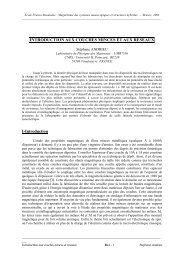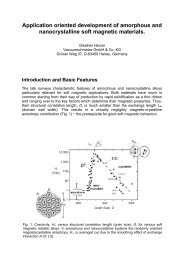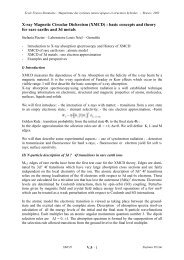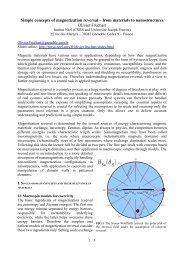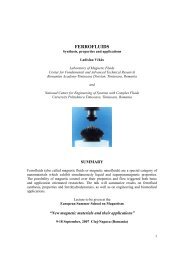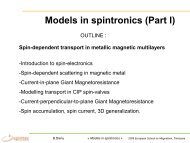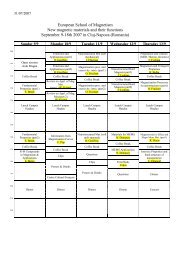Slides
Slides
Slides
Create successful ePaper yourself
Turn your PDF publications into a flip-book with our unique Google optimized e-Paper software.
3. Lecture:<br />
Basics of Magnetism:<br />
Local Moments<br />
Hartmut Zabel<br />
Ruhr-University Bochum<br />
Germany
Content<br />
1. Local moments of magnetic ions<br />
2. Hund‘s rules<br />
3. Magnetic moments of transition metal ions<br />
4. Crystal field splitting<br />
5. Magnetic moments of rare earth ions<br />
H. Zabel 3. Lecture: Local Moments<br />
2
1. Local moments of magnetic ions<br />
Orbital moment L and spin S combine to different total moment J<br />
The z-components m J may take any value from |L-S| to |L+S|, each<br />
2J+1 fold degenerate. The total number of combinations is:<br />
L<br />
∑ + S<br />
J = L−S<br />
( 2 J + 1) = ( 2L<br />
+ 1)( 2S<br />
+ 1)<br />
Example: L = 3, S=3/2<br />
• m J may take the values from<br />
|L-S| = 3/2 to |L+S| = 9/2<br />
• 28 Possible combinations are shown in the<br />
graph.<br />
• Which J corresponds to the ground state?<br />
⇒ Hund‘s rule.<br />
H. Zabel 3. Lecture: Local Moments<br />
3
2. Hund‘s Rules<br />
Hund‘s rules help to find the ground state. The empirical rules fullfill Pauli<br />
principle and should be followed in the sequence from more important to<br />
less important:<br />
1. First Hund‘s rule<br />
Maximize S without violating Pauli principle<br />
2. Second Hund‘s rule<br />
The states with largest m L are filled first<br />
3. Third Hund‘s rule<br />
Because of spin orbit coupling J takes the following values:<br />
J<br />
J<br />
= L − S for shells less than half filled<br />
= L + S<br />
for shells more than hald filled<br />
This is referred to as the Russel-Saunders-coupling scheme. It works only<br />
for weak LS – coupling, for stronger LS – coupling, i.e. for heavier<br />
elements, the j-j coupling dominates<br />
H. Zabel 3. Lecture: Local Moments<br />
4
Nomenclature for spectroscopic terms<br />
The ground state is written in the form<br />
2S +1<br />
L<br />
J<br />
J and S are expressed in numbers. For L capital letter are used:<br />
L = |ΣL z | = 0 1 2 3 4 5 6<br />
= S P D F G H I<br />
The spin is expressed by its multiplicity (2S+1).<br />
g j - value is calculated according to:<br />
g J<br />
= 1+<br />
J<br />
( J + 1) + S( S + 1) -L( L + 1)<br />
( )<br />
2J<br />
J + 1<br />
=<br />
3<br />
2<br />
+<br />
( + 1) -L( L + 1)<br />
( )<br />
S S<br />
2J<br />
J + 1<br />
H. Zabel 3. Lecture: Local Moments<br />
5
Examples<br />
Sc<br />
2+<br />
:<br />
3d<br />
1<br />
− 2<br />
2<br />
⎧<br />
⎪<br />
⎨<br />
⎪<br />
⎩J<br />
S<br />
L<br />
= 1<br />
=<br />
= L - S<br />
2<br />
2<br />
= 3<br />
2<br />
⇒<br />
2<br />
D 3<br />
2<br />
g J = 0.8<br />
2+<br />
Ti :<br />
2+<br />
Co :<br />
2<br />
3d<br />
7<br />
3d<br />
− 2<br />
2<br />
− 2<br />
2<br />
⎧ S = 1<br />
⎪<br />
⎨ L = 2 + 1 = 3<br />
⎪<br />
⎩J<br />
= L − S = 2<br />
⎧ S = 3 2<br />
⎪<br />
⎨L<br />
= 4 + 2 −1−<br />
2<br />
⎪<br />
⎩ J = L + S = 9<br />
2<br />
⇒<br />
= 3<br />
3<br />
F 2<br />
⇒<br />
4<br />
F 9<br />
2<br />
g J = 0.66<br />
g J = 1.33<br />
Ce :<br />
4f<br />
− 3<br />
⎧ S = 1<br />
⎪<br />
⎨ L = 3 + 2 = 5<br />
⎪<br />
⎩J<br />
= L − S = 4<br />
2+ 2<br />
4<br />
3<br />
⇒<br />
3<br />
H<br />
g J = 0.8<br />
H. Zabel 3. Lecture: Local Moments<br />
6
Overview of 3d-metal ions<br />
m L<br />
=<br />
H. Zabel 3. Lecture: Local Moments<br />
7
Splitting of energy states for L=3, S=3/2<br />
28 states<br />
Schematics from J.M.D. Coey<br />
H. Zabel 3. Lecture: Local Moments<br />
8
L and S according to Hund‘s Rule in 3d shell<br />
L=S<br />
H. Zabel 3. Lecture: Local Moments<br />
9
4. Magnetic moments for transition metal ions<br />
Metal ions in salts : Example: FeCl 2 with an ionic state: Fe 2+<br />
• For atomic Fe the electronic configuration is 3d 6 4s 2<br />
• The s-electron go into the ionic bond, remaining 3d 6 ,<br />
i.e. 6 electrons in the d-shell<br />
• Level scheme according to Hund‘s rule:<br />
mL3d<br />
6<br />
-2<br />
}<br />
1<br />
-1<br />
S = 4 ⋅ = 2<br />
2<br />
0<br />
L = 2<br />
1<br />
J = L + S = 4<br />
2<br />
Spectroscopic term:<br />
5 D4<br />
• Expected g J value:<br />
g J<br />
=<br />
3<br />
2<br />
+<br />
S<br />
( S + 1) - L( L + 1)<br />
2J<br />
( J + 1)<br />
=<br />
3<br />
2<br />
for S =<br />
L<br />
H. Zabel 3. Lecture: Local Moments<br />
10
Calculated effective magnetic moment<br />
p<br />
J<br />
If we consider spin only:<br />
3 3<br />
= gJ<br />
J(<br />
J + 1 ) = 4<br />
.<br />
2 2<br />
( 4+<br />
1) = 20 = 6 7<br />
p<br />
S<br />
=<br />
g<br />
S<br />
S( S + 1 ) = 2 2 ⋅ 3 = 4.<br />
89<br />
Experimentally determined:<br />
p exp = 5.4<br />
The experimentally determined value is closer to<br />
S<br />
p<br />
then to<br />
J<br />
p<br />
In most cases of transition metal ions the orbital<br />
momentum appears to be quenched.<br />
H. Zabel 3. Lecture: Local Moments<br />
11
Examples for 3d metal - ions<br />
Ion<br />
configuration<br />
Ground<br />
level<br />
J( J + 1)<br />
Ti 3+ ,V 4+ 3d 1 2 D 3/2 1.55 1.73 1.8<br />
V 3+ 3d 2 2 F 2 1.63 2.83 2.8<br />
Cr 3+ ,V 2+ 3d 3 2 F 3/2 0.77 3.87 3.8<br />
Mn 3+ , Cr 2+ 3d 4 2 D 0 0 4.90 4.9<br />
Fe 3 + , Mn 2+ 3d 5 2 S 5/2 5.92 5.92 5.9<br />
Fe 2+ 3d 6 2 D 4 6.70 4.90 5.4<br />
Co 2+ 3d 7 2 F 9/2 6.63 3.87 4.8<br />
Ni 2+ 3d 8 2 F 4 5.59 2.83 3.2<br />
Cu 2+ 3d 9 2 D 5/2 3.55 1.73 1.9<br />
p<br />
g<br />
J<br />
J<br />
=<br />
p<br />
g<br />
S<br />
S<br />
=<br />
S( S + 1)<br />
exp<br />
p<br />
H. Zabel 3. Lecture: Local Moments<br />
12
Magnetic moments of 3d-transition metal ions as a<br />
function of the number of electrons in the d-shell<br />
7<br />
6<br />
5<br />
4<br />
p J<br />
p S<br />
p<br />
calculated<br />
calculated<br />
exp.<br />
p eff<br />
3<br />
2<br />
1<br />
0<br />
-1<br />
0 2 4 6 8 10<br />
Elektronen in der d Schale<br />
The experimental values are closer to the calculated p S values than to<br />
the calculated p J -values<br />
H. Zabel 3. Lecture: Local Moments<br />
13
5. Crystal electrical field splitting<br />
• 3d-electrons take part in the chemical binding, not only the 4s<br />
electons (example: in FeCl 2 ,FeF 3 ,…)<br />
• The 3d-shell is exposed to strong inhomogeneous electrical fields, the<br />
crystal electric fields from the neighbors cause internal Stark-effect<br />
• The crystal electrical fields lifts the 2 L +1 degeneracy of the d-<br />
electrons<br />
• The m L levels are split into two parts<br />
• Octahedral environment: t 2g (ground level, three fold degenerate) and<br />
e g (upper level, doubly degenerate)<br />
free ion, L only<br />
m L<br />
-2<br />
-1<br />
0<br />
1<br />
2<br />
spherical symmetry ⇔ octahedral symmetry<br />
e g<br />
∆ = crystal field splitting<br />
t 2g<br />
H. Zabel 3. Lecture: Local Moments<br />
14
Crystal electrical field splitting<br />
‣ ∆ is the crystal field splitting between orbitals of different symmetry<br />
‣ Orbital moments of non-degenerate levels have no fixed phase<br />
relationship, orbital moments are not fixed and vary in time.<br />
‣ time average of the orbital moment L = 0<br />
‣ L 2 and L z are no longer good quantum numbers.<br />
‣ Hund‘s rules do not apply for a non-spehrical environment.<br />
H. Zabel 3. Lecture: Local Moments<br />
15
Crystal electrical field splitting with octahedral<br />
symmetry<br />
5 orthogonal wave functions of the d-shell<br />
e g<br />
d<br />
∆<br />
t 2g<br />
H. Zabel 3. Lecture: Local Moments<br />
16
Octahedral crystal field<br />
Max. probability<br />
density in direction<br />
of neighbors<br />
Low overlap<br />
with neighbors<br />
e g<br />
t 2g<br />
Repulsion, increase<br />
of of energy, e g<br />
e g<br />
Less repulsion,<br />
lowering of energy, t 2g<br />
Result:<br />
2 sets of d-orbitals<br />
No field<br />
Spherical<br />
symmetric<br />
field, energy<br />
lifted due to<br />
Coulomb int.<br />
Octahedra<br />
lligang<br />
field<br />
e g<br />
t 2g<br />
H. Zabel 3. Lecture: Local Moments<br />
17
Tetrahedral crystal field<br />
t 2g<br />
e g<br />
In tetrahedrally coordinated systems, e g and t 2g exchange their<br />
role, e g has the lower energy.<br />
The energy splitting is on the order of 1-10 µeV.<br />
H. Zabel 3. Lecture: Local Moments<br />
18
Adding all energy terms<br />
+ H CF<br />
λL ⋅ S<br />
<br />
µ 0<br />
m<br />
z , J<br />
H<br />
z<br />
adapted from J.M.D. Coey<br />
H. Zabel 3. Lecture: Local Moments<br />
19
Energy scales for CF and SO - splitting<br />
3d metals:<br />
‣SO splitting is an order of magnitude smaller, i.e. 50 meV<br />
‣CF is on the order of 500 meV<br />
RE-materials:<br />
‣SO-splitting on the order of 250 meV,<br />
In some cases SO splitting can be as low as 25 meV, in which<br />
case higher states mix with ground states at RT.<br />
‣CF-splitting is on the order of 10-15 meV or on the order<br />
of RT<br />
H. Zabel 3. Lecture: Local Moments<br />
20
Degeneracies in crystal fields<br />
p-levels<br />
No effect of<br />
crystal field<br />
Independent of<br />
oct. or tetr.<br />
environment<br />
Splitting of d-levels depends on symmetry<br />
of environment<br />
octahedral<br />
tetrahedral<br />
∆ O<br />
∆ t = 4/9∆ O<br />
adapted from J.M.D. Coey<br />
H. Zabel 3. Lecture: Local Moments<br />
21
Occupation of sublevels<br />
If crystal field splitting ∆ is bigger than LS-coupling:<br />
∆ >> λL<br />
⋅S<br />
<br />
i.e. crystal electric fields are bigger than internal magnetic fields, only<br />
lowest levels are occupied.<br />
Occupation for more than 1 electron in d orbitals:<br />
• For d 2 -d 9 systems the electron-electron interactions must be taken<br />
into account.<br />
• For d 1 -d 3 systems, Hund's rule applies and predicts that the electrons<br />
will not pair and occupy the t 2g set.<br />
H. Zabel 3. Lecture: Local Moments<br />
22
High spin – low spin case<br />
• For d 4 -d 7 systems, there are two possibilities:<br />
– low spin case or strong field situation: Electrons occupy t 2g<br />
set and pair up to 6 electrons, tnen occupy e g level.<br />
– high spin case or weak field situation; Electrons occupy t 2g<br />
and e g levels according to Hund’s rule.<br />
Example 3d 6 :<br />
∆ > λL<br />
• S<br />
<br />
Examples for high-spin low-spin transitions:<br />
1. Verwey transition of magnetite, Jahn-Teller transitions, oxy-deoxy transition<br />
H. Zabel 3. Lecture: Local Moments<br />
23
High spin – low spin transition<br />
in heme molecule with O 2 - cycling<br />
Heme protein.....<br />
Fe ++<br />
.....is magnetic<br />
3d 6 state<br />
w/o O 2 – binding<br />
deoxy<br />
with O 2 – binding<br />
oxy<br />
H. Zabel 3. Lecture: Local Moments<br />
24
Consequences from a strong crystal field<br />
If crystal field has low symmetry, the degeneracy is lifted and the time<br />
average yields zero orbital moment:<br />
L z<br />
= 0<br />
The ground state is characterized by an s-character and (2S+1)-<br />
degeneracy.<br />
= S and L<br />
The saturation magnetization is then:<br />
J<br />
Magnetization measurements yield directly S, the maximum S value in the<br />
d-shell is S=5/2 with m = 5µ B (i.e. Cr + (3d 5 4s 0 ) and Mn 2+ (3d 5 4s 0 )).<br />
= 0<br />
N N<br />
M<br />
S<br />
= gSµ<br />
BS<br />
= µ<br />
B<br />
2S<br />
V V<br />
H. Zabel 3. Lecture: Local Moments<br />
25
Transition metals: determination of g-value<br />
EPR – FMR resonance frequency:<br />
ω =<br />
gµ B B res<br />
g-value from the slope.<br />
Ratio of magnetic moments:<br />
m<br />
m<br />
L<br />
S<br />
= g − 2<br />
2<br />
M. Ulmeanu et al. PRB 69 (2004)<br />
Most metal ions show a g-value of 2.1 - 2.2.<br />
Thus, in reality the orbital contribution is on the order of 0.1 – 0.2,<br />
i.e. orbital moment is not completely quenched. Remaining orbital<br />
moment is responsible for magnetic anisotropy.<br />
H. Zabel 3. Lecture: Local Moments<br />
26
6. Magnetic moment of rare earth ions<br />
Crystal field splitting in rare earth ions is small in the meV-range:<br />
• The inner 4f - shell is well screened from the outer shells 5s 2 p 6 6s 2 ,<br />
which take part in the chemical bonding. Therefore, 4f electrons are<br />
more localized.<br />
• LS – coupling is strong because of higher Z atoms compared to the 3d<br />
atoms. Here the limit holds:<br />
∆
Wave functions of rare earth ions<br />
H. Zabel 3. Lecture: Local Moments<br />
28
Overview of 4f-rare earth ions<br />
m L<br />
=<br />
H. Zabel 3. Lecture: Local Moments<br />
29
L and S according to Hund‘s Rule in 4f shell<br />
H. Zabel 3. Lecture: Local Moments<br />
30
Example: Ce 3+ (one electron in the f-shell)<br />
1<br />
mL<br />
4f<br />
-3<br />
-2<br />
-1<br />
0<br />
1<br />
2<br />
3<br />
1<br />
}<br />
S =<br />
2<br />
L = 3<br />
1 5<br />
J = L -S<br />
= 3- =<br />
2 2<br />
3 3 4 -12<br />
g J<br />
= + = 0.<br />
857<br />
2 2×35 4<br />
p<br />
p<br />
2 F5/2<br />
J<br />
=<br />
g<br />
exp =<br />
J<br />
J<br />
2.<br />
4<br />
( J + 1)<br />
=<br />
2.<br />
53<br />
For rare earth ions with 3+ ionization, good agreement between<br />
calculated and measured p J –values:<br />
p<br />
J<br />
= g J( J + 1)<br />
≅ p<br />
J<br />
exp<br />
Therefore Hund‘s rule holds<br />
Magnetism follows from the Zeeman splitting of the lowest J-levels.<br />
H. Zabel 3. Lecture: Local Moments<br />
31
Examples for 4f-rare earth metal ions<br />
(near 300 K)<br />
0<br />
H. Zabel 3. Lecture: Local Moments<br />
32
Comparison of calculated and measured effective<br />
moments for rare earth ions<br />
calculated<br />
Sm 3+<br />
Exp.<br />
Eu 3+<br />
exp.<br />
Pm 3+ Eu 3+<br />
theory<br />
Electrons in 4f shell<br />
In general good agreement between theory and experiment, aside<br />
from some characteristic deviations.<br />
H. Zabel 3. Lecture: Local Moments<br />
33
Deviations for Sm 3+ und Eu 3+<br />
Reason: small L ⋅S - coupling for these ions.<br />
Examplel: Sm 3+ (configuration 4f 5 )<br />
5<br />
Lz<br />
4f<br />
}<br />
-3<br />
5<br />
S =<br />
6 H<br />
-2<br />
2<br />
5/2<br />
-1<br />
L = 2 + 3 = 5<br />
0<br />
1<br />
5 5<br />
J = L − S = 5 − =<br />
2<br />
2 2<br />
3<br />
The next higher term:<br />
p J<br />
p exp<br />
Sm 3+ 0.845 1.74<br />
Eu 3+ 0 3.4<br />
5 7<br />
J = L − S + 1 = + 1=<br />
or<br />
6 H<br />
2 2<br />
7/2<br />
H. Zabel 3. Lecture: Local Moments<br />
34
LS splitting for Sm<br />
LS –splitting<br />
Zeeman-splitting<br />
The L ⋅S splitting is of the order of 300 K, i.e. rather weak. Thus at RT<br />
levels of the higher states are already occupied. In a magnetic field,<br />
level mixing occurs.<br />
Similar argument also applies for Eu. Because of low LS-coupling, levels<br />
mix as a function of field and temperature.<br />
H. Zabel 3. Lecture: Local Moments<br />
35
ρ(r)<br />
3d-metal ions<br />
3d<br />
4s<br />
Summary<br />
a) 3d und 4s-electrons hybridize<br />
b) L ⋅S coupling is weak<br />
λL<br />
<br />
• S<br />
<br />
> ∆<br />
= c.f.<br />
H. Zabel 3. Lecture: Local Moments<br />
r<br />
36



